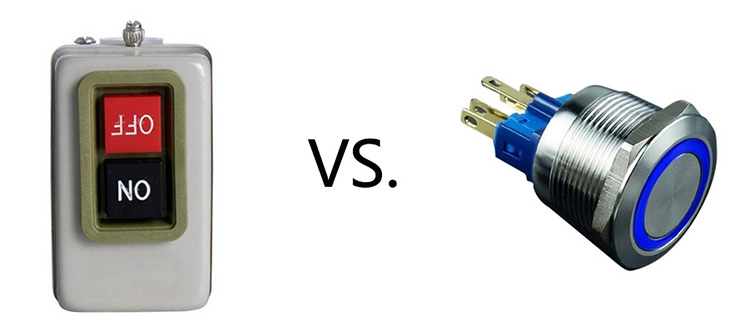Power Push Button vs. Momentary Push Button
In electronic and electrical devices, industrial push button are one of the most common control elements. Two common types of buttons are power push buttons and momentary push buttons. Although they may look similar, their functions and application scenarios are very different. This article will explore the characteristics, uses, and selection criteria of these two types of buttons in different occasions.
Power Push Button
Functional characteristics
Power push buttons are mainly used to control the switch of power. After the first press, they will remain activated, and they will remain activated even after the hand is released. To deactivate it, you must press it again. This type of switch is sometimes called a push-push switch because it needs to be operated again to change the state. Power push button switch is usually locked and can maintain the state of the device under different operating conditions.
Application scenarios
Power push buttons are widely used in devices that require continuous power supply, such as:
- Household appliances: such as washing machines, refrigerators, etc., after the user presses the button, the device starts to operate.
- Computer power: When starting the computer, the user presses the button to power it on until it is pressed again to turn off the power.
Advantages and disadvantages
- Advantages: The power push button is easy to operate, allowing users to control devices effortlessly, making it particularly suitable for applications that require long-duration operation.
- Disadvantages: May cause the device to continue to operate when it is not needed, increasing energy consumption.
Momentary Push Button
Functional characteristics
The momentary push button triggers a specific operation when pressed and returns to the initial state immediately after releasing. This type of switch does not require continuous pressing to maintain its state, and it will immediately return to its original state once the finger leaves the button. Momentary switches are suitable for occasions where only short-term operation is required, and are usually used as switches for signaling or starting a function. There are two types of momentary push buttons: normally open (NO) and normally closed (NC), which provide different circuit states when pressed and released respectively.
Application scenarios
Momentary push buttons are widely used in:
- Doorbell: rings when the button is pressed and stops when released.
- Sound control: momentary operation when adjusting the volume or switching tracks.
Advantages and disadvantages
- Advantages: The momentary push button offers flexible operation for short-term control, which can help reduce the risk of accidental activation in certain applications.
- Disadvantages: Not suitable for devices that require long-term operation.
Selection criteria
When choosing between a power push button and a momentary push button, the following aspects need to be considered:
- Application requirements: Determine whether the device needs to be turned on continuously or only operated briefly. For devices that need to maintain status, choose a power push button; for applications that require short signals, choose a momentary push button.
- Energy consumption considerations: Power push buttons may cause the device to run for a long time, so pay attention to energy consumption when choosing.
- User experience: Consider the convenience and intuitiveness of the user during operation. Different types of push buttons may affect the user's operating habits.
In short, the main difference between power push buttons and momentary push buttons lies in their operation continuity and application scenarios. Power push buttons require continuous pressing to maintain their activated state, while momentary push buttons return to the inactive state immediately after the finger is removed. These two types of buttons play different roles in various devices and systems according to their respective characteristics and uses. You can visit ATO online shop to choose push button.
Understanding their functional characteristics and applicable scenarios can help users make more appropriate choices when designing and using equipment. Whether it is for home appliances or industrial automation, correctly selecting the type of button is an important step in achieving efficient operation of the equipment.


